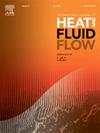Numerical simulation of fractional order double diffusive convective nanofluid flow in a wavy porous enclosure
IF 2.6
3区 工程技术
Q2 ENGINEERING, MECHANICAL
International Journal of Heat and Fluid Flow
Pub Date : 2025-02-04
DOI:10.1016/j.ijheatfluidflow.2025.109749
引用次数: 0
Abstract
Fractional order models are becoming a promising tool for modeling complex physical phenomena due to their non-local and memory-dependent properties. In this study, a novel fractional order double-diffusion model is proposed to analyze the transient nature of fluid flow, convective heat, and the solute transfer phenomena within a wavy porous cavity. The fractional time derivative is defined in the Caputo sense for an order of and is incorporated into the governing equations formulated using the Darcy-Brinkman-Forchheimer model, along with energy and mass transfer equations. The resulting coupled nonlinear fractional partial differential equations (FPDEs) are subjected to numerical simulation using a fully discrete scheme comprising an L1 finite difference scheme for temporal discretization and a penalty finite element scheme for spatial discretization. The double-diffusion process undergoes varying evolution phases for each . It is observed that a higher value of the fractional order parameter accelerates the evolution rate, leading to faster convergence towards steady-state conditions. Additionally, this study also explores the impacts of various parameters such as the Rayleigh number, buoyancy ratio, Darcy number, porosity, and Lewis number on thermal and solute transport processes.
求助全文
约1分钟内获得全文
求助全文
来源期刊

International Journal of Heat and Fluid Flow
工程技术-工程:机械
CiteScore
5.00
自引率
7.70%
发文量
131
审稿时长
33 days
期刊介绍:
The International Journal of Heat and Fluid Flow welcomes high-quality original contributions on experimental, computational, and physical aspects of convective heat transfer and fluid dynamics relevant to engineering or the environment, including multiphase and microscale flows.
Papers reporting the application of these disciplines to design and development, with emphasis on new technological fields, are also welcomed. Some of these new fields include microscale electronic and mechanical systems; medical and biological systems; and thermal and flow control in both the internal and external environment.
 求助内容:
求助内容: 应助结果提醒方式:
应助结果提醒方式:


